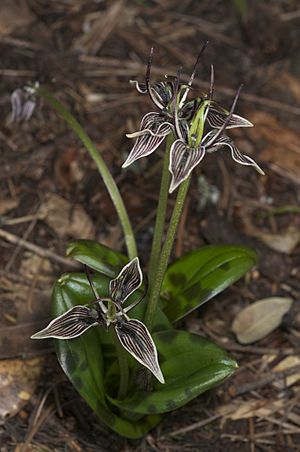Scoliopus bigelovii facts for kids
Quick facts for kids California fetid adderstongue |
|
|---|---|
 |
|
| Scientific classification | |
| Genus: |
Scoliopus
|
| Species: |
bigelovii
|
The California fetid adderstongue is a very special flowering plant. It is part of the lily family. People also call it Bigelow's adderstongue, slinkpod, or brownies. It gets its "fetid" name because its flowers have a slightly unusual smell. This plant is native to California. It grows in places like San Luis Obispo County and parts of the San Francisco Bay Area. You can also find it in the North Coast Ranges. A few have even been found just over the border in Oregon.
Contents
Discovering the California Fetid Adderstongue
Where Does This Plant Live?
This interesting plant is native to California. It grows in old, natural forests. You can find it under tall redwood trees. It likes places that are moist and mossy. It also prefers shady spots.
What Does This Plant Look Like?
The California fetid adderstongue is a herbaceous perennial plant. This means it has soft stems, not woody ones. It also lives for more than two years. It grows from an underground stem called a rhizome.
The plant usually has two large leaves. Each leaf can be up to 24 centimeters (about 9.5 inches) long. They can also be up to 10 centimeters (about 4 inches) wide. Sometimes, a plant might have three or four leaves. These leaves are green. They have darker green or purplish spots and stripes. They also have several veins running along them.
The Unique Flowers
The flowers of this plant grow in a special way. They appear to rise separately from the ground. But they are actually part of a cluster called an umbel. The main flower stem is mostly underground. Between 3 and 12 smaller stems, called pedicels, grow above the ground. Each pedicel holds a flower.
Each flower has three flat, pointed parts called sepals. These sepals are pale green. They have dark purple stripes or streaks. The flower also has three narrower petals. These petals are shaped like fingers. The flower has a smell that some people find unpleasant. There are three short stamens in the flower. These are found at the base of the sepals. The flower also has a style with three long, curving branches.
How Does This Plant Reproduce?
After the flower is pollinated, it forms a fruit. This fruit is a small case called a capsule. As the fruit gets ready, the stem holding it twists. It bends down to touch the ground. This helps the seeds get to the soil.
Pollination and Seed Spreading
The flowers are pollinated by tiny insects. These insects are called fungus gnats. Different types of fungus gnats help pollinate the plant. These include gnats from the Mycetophilla, Sciara, and Corynoptera groups.
Once the seeds are ready, they are spread by ants. Ants like Formica fusca, Formica rufibaris, and Aphaenogaster subterranea help move the seeds around. This is how the plant spreads to new places.

